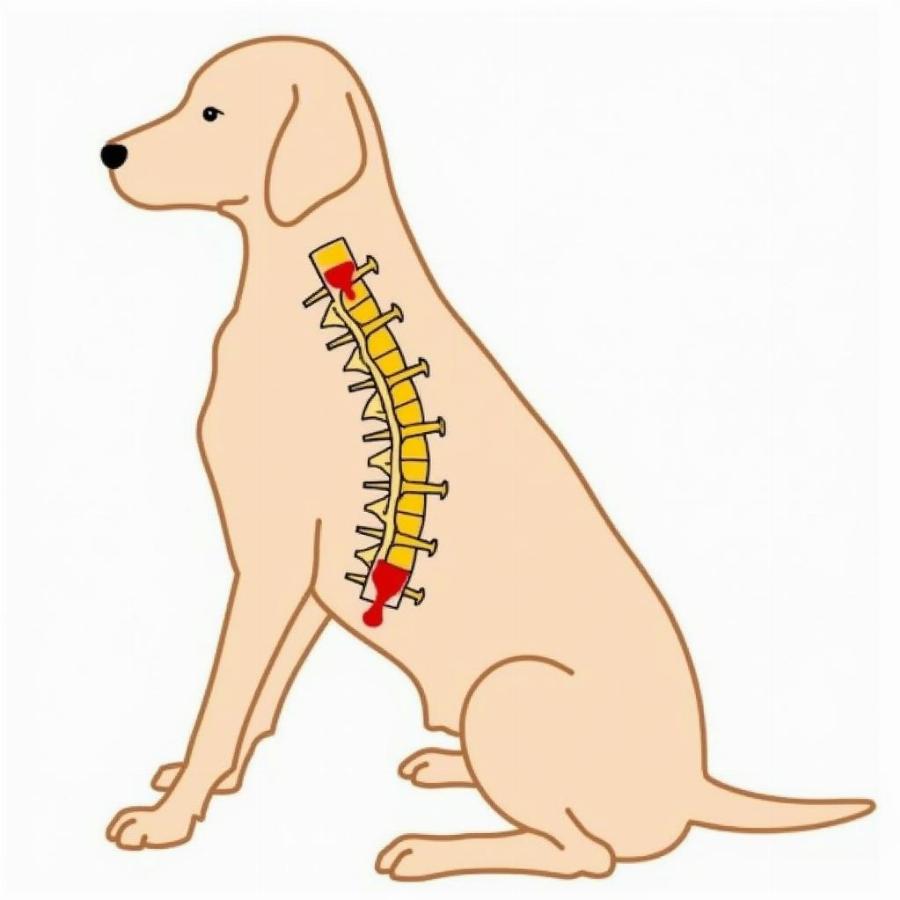A trapped nerve in a dog can be a painful and debilitating condition. It occurs when pressure is placed on a nerve, disrupting its ability to function properly. This pressure can stem from various sources, from a slipped disc to inflammation. Recognizing the signs of a trapped nerve is crucial for early diagnosis and effective treatment. This article will delve into the causes, symptoms, diagnosis, and treatment options for trapped nerves in dogs, empowering you to provide the best possible care for your furry friend.
Understanding Trapped Nerves in Dogs
A trapped nerve, also known as a pinched nerve or nerve compression, occurs when surrounding tissues, such as bones, cartilage, muscles, or tendons, exert excessive pressure on a nerve. This pressure can interfere with the nerve’s ability to transmit signals effectively, leading to a range of symptoms from mild discomfort to severe pain and paralysis. Understanding the underlying mechanisms of a trapped nerve is key to recognizing the signs and seeking appropriate veterinary care.
Common Causes of Trapped Nerves
Several factors can contribute to a trapped nerve in dogs. Some of the most common causes include:
- Intervertebral Disc Disease (IVDD): This occurs when the cushioning discs between the vertebrae degenerate or rupture, putting pressure on the spinal cord and nerves. IVDD is particularly common in certain breeds like Dachshunds, Beagles, and Shih Tzus.
- Arthritis: Inflammation and swelling in the joints can compress nearby nerves, causing pain and restricted movement.
- Trauma: Injuries, such as fractures or dislocations, can directly damage nerves or create pressure that leads to nerve compression.
- Tumors: Growths, whether benign or malignant, can press on nerves, disrupting their function.
- Obesity: Excess weight puts added strain on joints and can contribute to nerve compression.
 Dog with Trapped Nerve in Spinal Cord
Dog with Trapped Nerve in Spinal Cord
Recognizing the Signs of a Trapped Nerve
The symptoms of a trapped nerve can vary depending on the location and severity of the compression. Some common signs to watch for include:
- Pain: This can range from mild discomfort to intense, sharp pain. Your dog may yelp, whimper, or show signs of distress when the affected area is touched.
- Lameness or Limping: If a nerve in a leg is compressed, your dog may have difficulty walking or putting weight on the affected limb.
- Muscle Weakness or Atrophy: A trapped nerve can lead to weakness and eventual muscle wasting in the area supplied by the affected nerve.
- Changes in Posture: Your dog may adopt an unusual posture, such as hunching their back or holding their head low, to alleviate pain.
- Difficulty Moving or Stiffness: Your dog may be reluctant to move, climb stairs, or jump.
- Loss of Coordination: In severe cases, nerve compression can lead to stumbling, falling, or difficulty maintaining balance.
Diagnosing and Treating a Trapped Nerve
If you suspect your dog has a trapped nerve, it’s crucial to seek veterinary attention promptly. The veterinarian will perform a thorough physical examination and may recommend additional diagnostic tests, such as X-rays, CT scans, or MRIs, to pinpoint the location and cause of the nerve compression.
Treatment options will vary depending on the underlying cause and severity of the condition. They may include:
- Rest and Restricted Activity: Reducing activity and providing a comfortable resting place can help alleviate pressure on the nerve and promote healing.
- Medication: Pain relievers, anti-inflammatory drugs, and muscle relaxants can help manage pain and inflammation.
- Physical Therapy: Targeted exercises and stretches can help improve muscle strength, flexibility, and range of motion.
- Surgery: In severe cases, surgery may be necessary to remove the source of pressure on the nerve, such as a herniated disc or tumor.
What to Expect After Treatment
Recovery time depends on the severity of the nerve compression and the chosen treatment method. Your veterinarian will provide specific instructions for post-treatment care, which may include:
- Continued Rest and Restricted Activity: Gradual resumption of activity is essential to prevent re-injury.
- Medication: Your dog may need to continue taking medication for a period to manage pain and inflammation.
- Physical Therapy: Ongoing physical therapy may be recommended to maintain muscle strength and flexibility.
- Follow-up Veterinary Visits: Regular check-ups are important to monitor your dog’s progress and adjust treatment as needed.
Conclusion
A dog trapped nerve can be a serious condition, but with prompt diagnosis and appropriate treatment, most dogs can recover and regain their mobility and quality of life. By understanding the causes, symptoms, and treatment options for trapped nerves, you can be better prepared to provide the care your furry companion needs.
FAQ
- What are the first signs of a trapped nerve in a dog? Pain, lameness, muscle weakness, changes in posture, and difficulty moving are common early signs.
- Can a trapped nerve heal on its own? Mild cases may resolve with rest, but more severe cases often require veterinary intervention.
- How is a trapped nerve diagnosed? Veterinarians typically use a combination of physical examination and diagnostic imaging, such as X-rays, CT scans, or MRIs.
- What is the best treatment for a trapped nerve? Treatment depends on the underlying cause and may include rest, medication, physical therapy, or surgery.
- How long does it take for a trapped nerve to heal? Recovery time varies depending on the severity of the condition and the chosen treatment method.
- Can I prevent my dog from getting a trapped nerve? Maintaining a healthy weight, providing regular exercise, and avoiding strenuous activities can help reduce the risk.
- What should I do if I suspect my dog has a trapped nerve? Contact your veterinarian immediately for diagnosis and treatment recommendations.